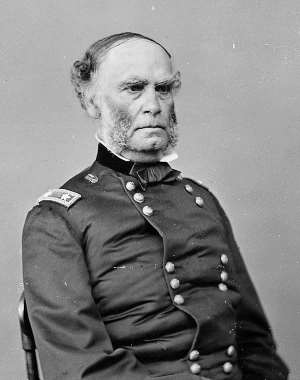Samuel R. Curtis

Samuel Ryan Curtis was born in 1805 in New York while his family was en route to settle in Ohio. Curtis graduated from West Point in 1831 and was commissioned a lieutenant in the 7th US Cavalry, but resigned in 1832. Curtis used his army training to obtain a position in Ohio as chief engineer of the Muskingum River Improvement. Curtis served as a colonel of volunteers in the Mexican War. After the war Curtis relocated to Iowa and became the chief engineer for the Des Moines River Improvement and then for the American Central Railroad. In 1856 Curtis, running as a Republican, was elected to Congress. Curtis represented Iowa in the US House of Representatives from 1857 to 1861. His railroad experience got him an appointment to the Congressional Select Committee on the Pacific Railroad. He was a Republican and supported Abraham Lincoln's election for President. He was in the middle of his third term when the American Civil War began.
On June 1, 1861, Curtis received an appointment as Colonel in the 2d Iowa Infantry. He was soon promoted to Brigadier General. For the rest of 1861, Curtis was in charge of the Jefferson Barracks in St. Louis, Missouri. On December 25, 1861, Curtis was made commander of the Union Army of the Southwest by Maj. Gen. Henry W. Halleck. Curtis made his headquarters in Rolla, Missouri and took a series of actions in the winter of 1861 and 1862 to push Sterling Price's army out of Missouri.
Curtis took his Army of the Southwest into Arkansas in pursuit of Price. Around the same time, Major General Earl Van Dorn, Commander of the Trans-Mississippi District for the Confederacy, had decided to move north and attack Curtis's army. Both armies engaged in Arkansas at the Battle of Pea Ridge. The result was a Union victory that secured Missouri for the Union. Curtis was promoted to major general of volunteers in March 1862.
Following his victory at Pea Ridge, Curtis moved east and south through Arkansas securing a number of Arkansas towns, including Helena, for the Union. While in Helena, Curtis came under suspicion of performing a number of controversial and illegal activities. Subsequently he was removed from field command and made the Commander of the Department of Missouri in September 1862. He encountered political troubles in this position and fell out of favor with President Lincoln. He was removed as commander of the Department of Missouri in May 1863.
In January 1864, Curtis was named the Commander of the Department of Kansas. Later that year in October Curtis was in command of the Army of the Border that helped to defeat Sterling Price's Army of Missouri during the Battle of Westport.
Curtis was reassigned to the Department of the Northwest in January 1865 to put down uprising by Native Americans and stayed there through the end of the war.
After the war, Curtis served as an Indian Commissioner. He also was active with the Union Pacific Railroad until his death in Council Bluffs, Iowa. He was buried in Oakland Cemetery, Keokuk.